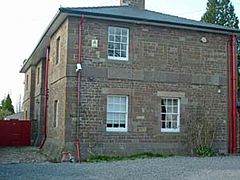Monmouth County Gaol
| Monmouth County Gaol | |
|---|---|

The gatehouse to the former County Gaol
|
|
| General information | |
| Type | Prison |
| Town or city | Monmouth |
| Country | Wales |
| Coordinates | 51°49′1.3″N 2°42′48.9″W / 51.817028°N 2.713583°WCoordinates: 51°49′1.3″N 2°42′48.9″W / 51.817028°N 2.713583°W |
| Construction started | 1788 |
| Completed | 1790 |
| Cost | £5,000 |
| Design and construction | |
| Architect | William Blackburn |
| Designations | Grade II listed |
The County Gaol, situated in North Parade, Monmouth, Wales, was Monmouthshire's main prison when it was opened in 1790. A castellated mediaeval fortress, it served as the county jail of Monmouthshire and criminals or those who fell foul of the authorities were hanged here until the 1850s and some 3,000 people viewed the last hanging. The jail covered an area of about an acre, with a chapel, infirmary, living quarters and a treadmill. It was closed in 1869. In 1884 most of the building was demolished, and today nothing remains but the gatehouse which is a Grade II listed building. Within the gatehouse, there exists "a representation in coloured glass of the complete original buildings". It is one of 24 buildings on the Monmouth Heritage Trail.
The gaol was designed by William Blackburn and constructed between 1788 and 1790. It was designed as a reformed gaol, following the principles of the first prison reformer John Howard. The first Governor was James Baker, who received £100 per annum. The gaol cost around £5,000 to build, on land procured from Henry Somerset, 5th Duke of Beaufort and was constructed of local stone, some 18,000 tons of which was removed from a quarry situated in Lower Redbrook.
A nineteenth-century print gives an idea of the gaol's size and strength, and shows the gatehouse in the centre of the south wall. Contemporary descriptions speak of "a massive building looking more like a castle than a gaol, having high outer walls and an inner building complete with tall round bastions". It was commended "for the commodious distribution of the whole, the airiness of the compartments, the propriety of the regulations, and the strict attention paid to the cleanliness and morals of the prisoners". Inmates imprisoned in the gaol for debt could expect a bedstead, sheets, two blankets in the winter and a rug. They would also be given a sixpenny loaf four times a year as the result of a bequest of a Monmouth man who left £100 for that purpose.Generally, the prisoners' diet was poor in the extreme. Felons were allowed 1d of bread a day, but there was no allowance for debtors.John Howard, the penal reformer, noted that many debtors survived on 'water soup' - soup which consisted of bread boiled in water.
...
Wikipedia
